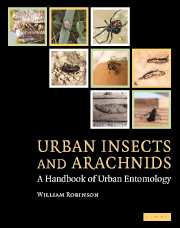3 - Pest status and pest control
Published online by Cambridge University Press: 06 August 2009
Summary
Introduction
Pest status for arthropods in the urban environment is based, in part, on the continued presence of a species in or around the workplace and living space. Contributing to this is the potential medical or psychological reaction and economic loss linked to their occurrence. The continued presence of these animals is due, in part, to the relative ineffectiveness of control measures, and the existence of reservoir habitats and populations that provide for reinfestation. Long-term persistence and pest status of domestic and peridomestic arthropods are based on a network of small infestations in relatively unstable habitats, and large reservoir populations in relatively stable habitats. Reservoir habitats provide individuals or groups that can replenish local infestations and establish new ones. Without their reservoir populations, most of the common pest species would not sustain the abundance necessary for pest status.
Pest status is usually associated with a real or perceived medical threat, a persistent nuisance, or on economic loss. The majority of arthropods in this environment qualify for one or more of these categories. Pest status may change with the abundance of the pest species. It may begin as a nuisance by the presence of small numbers of individuals, then become a health threat by the presence of large numbers, and eventually an economic level is reached when control and repair are required.
- Type
- Chapter
- Information
- Urban Insects and ArachnidsA Handbook of Urban Entomology, pp. 15 - 32Publisher: Cambridge University PressPrint publication year: 2005



